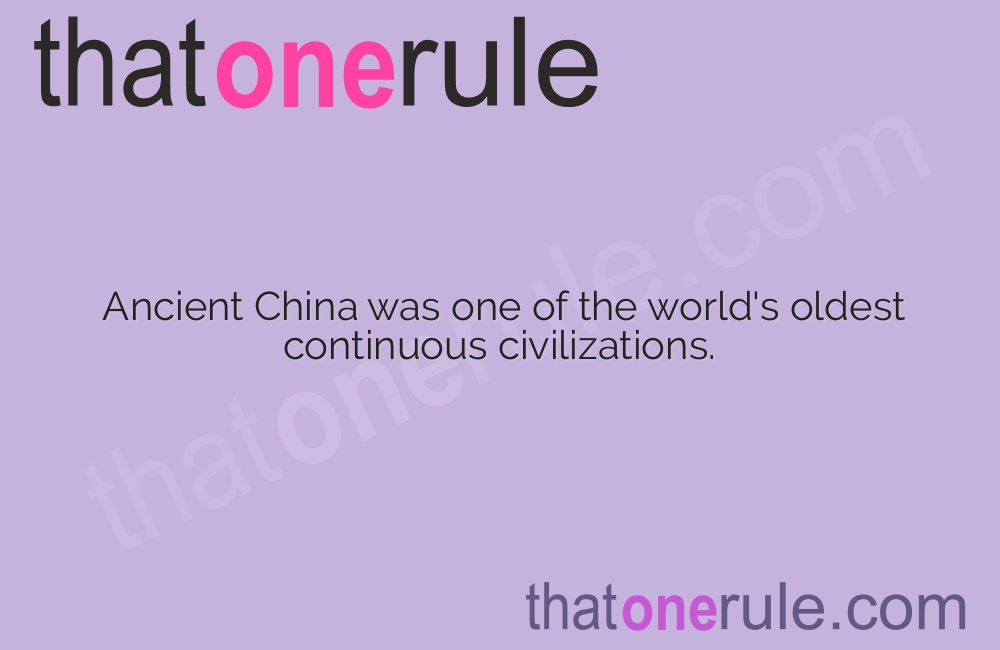Ancient China – Fascinating Facts and Historical Highlights

Ancient China was one of the world’s oldest continuous civilizations.
China invented paper and printing, which revolutionized communication.
The Great Wall of China is one of the Seven Wonders of the World.
The ancient Chinese civilization developed one of the earliest forms of writing.
China produced some of the most beautiful and intricate pottery in history.
The ancient Chinese practiced Taoism, Confucianism, and Buddhism.
Chinese civilization thrived along the Yellow River, also known as the cradle of Chinese civilization.
Chinese emperors were considered to be divine rulers and held absolute power.
The silk produced in ancient China was highly sought after by other civilizations.
Ancient Chinese medicine was advanced, with the use of acupuncture and herbal remedies.
Chinese dynasties ruled over vast territories, including modern-day Taiwan, Tibet, and parts of Mongolia.
The ancient Chinese were pioneers in agriculture and irrigation techniques.
Chinese astronomers made significant discoveries, including the accurate prediction of eclipses.
The Forbidden City in Beijing served as the imperial palace for multiple Chinese dynasties.
Ancient Chinese society was highly hierarchical, with strict social divisions.
China’s ancient philosophy emphasized harmony with nature and the balance of yin and yang.
Ancient Chinese cuisine is renowned worldwide for its rich flavors and diverse ingredients.
Ancient China – Fascinating Facts and Historical Highlights part 2
The invention of gunpowder by the ancient Chinese had a profound impact on warfare.
Chinese calligraphy is considered to be both an art form and a means of communication.
Ancient Chinese architecture is characterized by its intricate designs and use of wood and stone.
The Chinese invention of the compass revolutionized navigation and exploration.
Chinese martial arts, such as Kung Fu and Tai Chi, have a long history and continue to be practiced today.
Tea originated in ancient China and has become one of the world’s most popular beverages.
The ancient Chinese believed in the importance of balance in all aspects of life.
China’s ancient trading routes, such as the Silk Road, connected it to civilizations in the Middle East and Europe.
The terracotta army in Xi’an is a testament to the ancient Chinese belief in the afterlife.
Ancient Chinese folklore and mythology are filled with fascinating tales of gods, heroes, and mythical creatures.
Chinese emperors were often patrons of the arts and encouraged the development of literature and music.
Ancient China had a complex system of government, with bureaucracy and civil service exams.
Chinese inventions, such as the compass and paper money, had a significant impact on global history.
The Tai Chi symbol, known as the yin-yang, represents the balance of opposing forces in the universe.
The ancient Chinese were skilled in the art of porcelain making, creating delicate and highly sought-after ceramics.
China’s ancient philosophy, as espoused by Confucius, emphasized the importance of ethics and morality.
The ancient Chinese believed in the concept of filial piety, or respect for one’s parents and ancestors.
Chinese embroidery and silk weaving were considered high arts in ancient China.
Ancient Chinese writing used ideograms, symbols that represented concepts or objects.
The Chinese zodiac, based on a 12-year cycle, is still widely used for characterizing personality traits.
Chinese women in ancient times had a higher status compared to women in many other civilizations.
Ancient Chinese architecture incorporated principles of feng shui, which aims to harmonize human-made structures with the natural environment.
China’s ancient philosophers, such as Laozi and Mozi, contributed to the development of ethical and political theories.
Traditional Chinese painting emphasized the beauty of nature and capturing the spirit of the subject.
Ancient Chinese fashion was diverse and influenced by regional cultures and dynastic trends.
The ancient Chinese had a deep respect for their ancestors and practiced elaborate ancestor worship rituals.
China’s landscape, with its mountains, rivers, and terraced fields, has long inspired poets and artists.
The enduring legacy of ancient China can be seen in its traditions, values, and continued influence on global culture.

